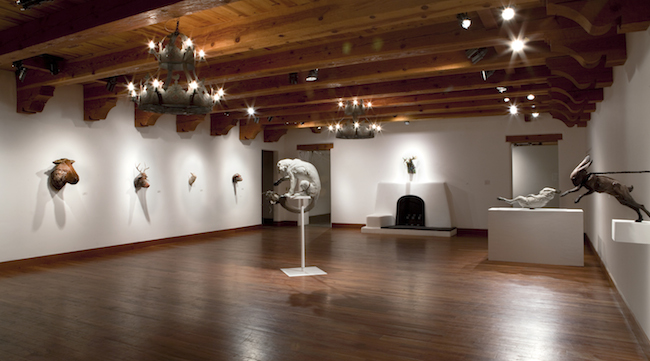Photographs are back from CFile’s benefit show at Peters Projects in Santa Fe. Trophies and Prey: A Contemporary Bestiary is on display from Aug. 7 – Oct. 3rd. It is curated by CFile Editor-in-Chief Garth Clark and by Mark Del Vecchio. The catalog is available here.

The exhibition was recently the subject of an Artsy editorial by Karen Kedmey. She states:
The word “bestiary” in the show’s title refers to a literary form, which peaked in popularity during the Middle Ages. A collection of descriptions of real and imaginary animals, a bestiary was distinguished from a scientific work in that it provided moral interpretations of the animals’ habits and was meant to instruct readers in their own behavior. Similarly, the sculptures included in the exhibition provide much more than aesthetic pleasure. Many of the ceramic and mixed-media animals on view here bear the marks of our use and abuse, and our general disregard for their lives.
The term, Bestiary, coined in 1840, has literary roots. Webster’s dictionary describes it as, “a medieval allegorical or moralizing [volume] on the appearance and habits of real or imaginary animals.” Also known as a Bestiarum vocabulum, it has roots in the ancient world but became popular during medieval times. It was an illustrated compendium of animals and plants, even rocks. But each subject was given virtuous meaning and often used animal actions as metaphors for human behavior (and misbehavior).
The curators, the internationally known authors, critics and ceramophiles, Garth Clark and Mark Del Vecchio, have assembled a contemporary bestiary in 3-D. Eleven artists—Undine Brod, Jeremy Brooks, John Byrd, Beth Cavener, Michelle Erickson, Alessandro Gallo, Jan Huling, Jeff Irwin, Kate MacDowell, Wookjae Maeng, Adelaide Paul—each bring their personal narratives; their charming and disturbing, wry and shocking observations, as well as their ethical questions about animal and man, explored mostly through the notion of a trophy.
At times the trophy in this exhibition is an abstract concept, at other times it is direct, the beheading of a creature and hanging its head and horns as an adornment on a wall. In the past this testified to the hunter’s valor, skill and ability to bring meat to the table. The hunting lodge of yore is a rich, visceral, pungent, masculine and atavistic piece of history at once heroic, intoxicating and for some, repellent (as anyone who has visited in the Musée de la Chasse et de la Nature (Museum of Hunting and Nature) in Paris can attest.


The hunting lodge of today, however, is a very different matter. Tracking and killing animals is now purely a sport, with ethical and unethical practices, and is not essential for survival. That throws the notion of trophy into a different light. As one confronts the art, the animals in the galleries, often avatars for humans, look back at the viewer and ask, (Adelaide Paul’s work Trophy Wife being a good example) who truly is the hunter and who is the prey?
Welcome to the postmodern hunting lodge.
Love contemporary ceramic art? Let us know in the comment box below.



Installation images from “Trophies and Prey: A Contemporary Bestiary” at Peters Projects in Santa Fe, 2015.





I had so wanted to see the show while I was in Santa Fe; but the time was not available when I could get to the gallery. Indian Market was so overwhelming that I wish I had spent more time in some of the fine galleries… I love Beth Cavener’s work
and hope to see more from her soon.
Fabulous show! I’ve been back twice now and each time glean something new. Very provocative work.